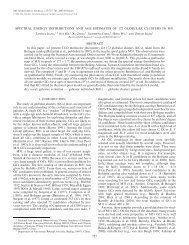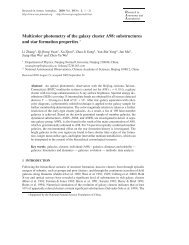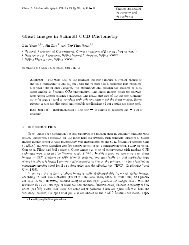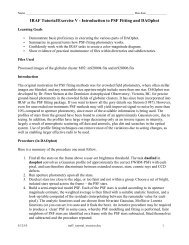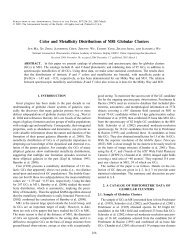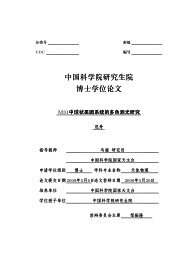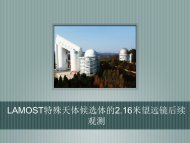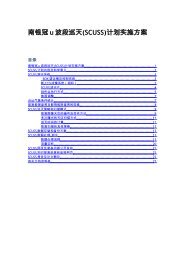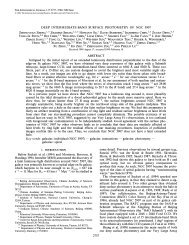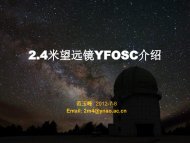Wen,Z.L.,Yang,Y.B.,Zhou,X.,Yuan,Q.R.,Ma,J ... - BATC home page
Wen,Z.L.,Yang,Y.B.,Zhou,X.,Yuan,Q.R.,Ma,J ... - BATC home page
Wen,Z.L.,Yang,Y.B.,Zhou,X.,Yuan,Q.R.,Ma,J ... - BATC home page
Create successful ePaper yourself
Turn your PDF publications into a flip-book with our unique Google optimized e-Paper software.
528 Z. L. <strong>Wen</strong>, Y. B. <strong>Yang</strong>, X. <strong>Zhou</strong> et al.<br />
and clusters may be different, which would lead to large systematic errors in the estimation of the space<br />
density of clusters.<br />
With the cluster selection and uncertainty of photometric redshift, we assume the number count of the<br />
LRGs to be one-fourth that of cluster members. The number of galaxies in the cluster sample corresponds<br />
to 15% of the total number of galaxies. Considering that the M/L ratio of cluster galaxies is twice as much<br />
as that of field galaxies (Colín et al. 1999), the expected Ω m of the universe should be raised by a factor<br />
of 4.<br />
6 CONCLUSIONS<br />
From the Sloan wide-field photometric and spectroscopic survey, we selected galaxy clusters utilizing<br />
photometric redshifts of galaxies. After excluding foreground and background galaxies, we measured<br />
the local projected densities of LRGs. The clusters were identified based on LRGs with density contrast<br />
δ > 2 and galaxy counts larger than 12. The algorithm selected more than 20,000 clusters from<br />
SDSS DR4 ∼ 5000 deg 2 , with expected velocity dispersion ∼ 400 − 600 km s −1 and space density<br />
n =5× 10 −5 h 3 Mpc −3 .<br />
We measured the two point angular cross-correlation between these clusters and SDSS bright QSOs<br />
(i ′ < 19), and found significant positive correlation. Because the slope of number-magnitude relation is<br />
steep for the QSOs, gravitational lensing is suggested as the physical process to produce the signal. We<br />
model clusters as singular isothermal spheres (SIS) and NFW profile halos. The best-fit for the SIS model<br />
requires the velocity dispersion to be 766 km s −1 , and for NFW model, a halo mass with 1.5 h −1 Mpc to<br />
be 4.6 × 10 14 h −1 M ⊙ . The mass parameter Ω cl of the cluster sample is deduced to be Ω cl =0.077 for<br />
the SIS model and Ω cl =0.083 for the NFW model, both of which are higher than the observational value.<br />
We argue that the overestimate may be caused by the cluster environment and the line-of-sight effect. By<br />
comparing, we find that the systematic errors in Ω cl in Croom & Shanks (1999) and Myers et al. (2003) are<br />
much reduced.<br />
Acknowledgements We sincerely thank the referee for many suggestions. We are grateful to Chen Xue-<br />
Lei and Chen Da-Ming for their valuable comments. We like to thank Wu Zhen-Yu, Wu Jiang-Hua,<br />
Zhang Lin-Di, Duan Zhi-Yu and David Burstein for the useful discussions. This work has been supported<br />
by the National Natural Science Foundation of China, though Grants 10473012 and 10573020.<br />
Funding for the SDSS and SDSS-II has been provided by the Alfred P. Sloan Foundation, the Participating<br />
Institutions, the National Science Foundation, the U.S. Department of Energy, the National Aeronautics and<br />
Space Administration, the Japanese Monbukagakusho, the <strong>Ma</strong>x Planck Society, and the Higher Education<br />
Funding Council for England. The SDSS Web Site is http://www.sdss.org/. The SDSS is managed by the<br />
Astrophysical Research Consortium for the Participating Institutions. The Participating Institutions are the<br />
American Museum of Natural History, Astrophysical Institute Potsdam, University of Basel, Cambridge<br />
University, Case Western Reserve University, University of Chicago, Drexel University, Fermilab, the<br />
Institute for Advanced Study, the Japan Participation Group, Johns Hopkins University, the Joint Institute<br />
for Nuclear Astrophysics, the Kavli Institute for Particle Astrophysics and Cosmology, the Korean Scientist<br />
Group, the Chinese Academy of Sciences (LAMOST), Los Alamos National Laboratory, the <strong>Ma</strong>x-Planck-<br />
Institute for Astronomy (MPIA), the <strong>Ma</strong>x-Planck-Institute for Astrophysics (MPA), New Mexico State<br />
University, Ohio State University, University of Pittsburgh, University of Portsmouth, Princeton University,<br />
the United States Naval Observatory, and the University of Washington.<br />
References<br />
Abazajian K., Adelman-McCarthy Jennifer K., Agüeros <strong>Ma</strong>rcel A. et al., 2004, AJ, 128, 502<br />
Abell G. O., 1958, ApJS, 3, 211<br />
Bahcall N. A., et al. 2003, ApJS, 148, 243<br />
Bartelmann M., Schneider P., 1992, A&A, 259, 413<br />
Bartelmann M., Schneider P., 1993, A&A, 271, 421<br />
Bartelmann M., Schneider P., 1994, A&A, 284, 1<br />
Bartsch A., Schneider P., Bartelmann M., 1997, A&A, 319, 375<br />
Benítez N., Sanz J. L., <strong>Ma</strong>rtínez-González E., 2001, MNRAS, 320, 241




